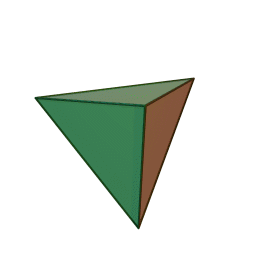Platonic solids
According to Wikipedia
The Platonic solids, also known as Platonic bodies, bodies cosmic Pythagorean solids, solid perfect, Plato's polyhedra or, more accurately, convex regular polyhedra, are characterized as geometric polyhedra whose faces are equal regular polygons and whose vertices bind the same number of faces. DEFINITION
will take that as a reference for defining the Platonic solids (which obviously are named after Plato who first studied them)
All those who read this blog is sure to have known any of them, but may not call it that. The list of the Platonic solids is small, since no other solid meets those conditions.
are 5 Platonic solids:

 The cube or hexahedron, with 6 square faces and an angle of 90 °
The cube or hexahedron, with 6 square faces and an angle of 90 °  The octahedron, with 8 equilateral triangular faces and an angle of 109.47 º
The octahedron, with 8 equilateral triangular faces and an angle of 109.47 º  The icosahedron, with 20 equilateral triangular faces and an angle of 138.19 º
The icosahedron, with 20 equilateral triangular faces and an angle of 138.19 º  The dodecahedron, with 12 regular pentagonal faces and an angle of 116.56 º
The dodecahedron, with 12 regular pentagonal faces and an angle of 116.56 º Once known, study their properties
- Regular:
- All faces of a Platonic solid are equal regular polygons.
- In all the vertices of a Platonic solid attend the same number of faces and edges.
- All edges of a Platonic solid are the same length.
- All dihedral angles formed by the faces of a Platonic solid with each other are equal.
- All its vertices are convex to the icosahedron.
-
The Platonic solids are highly symmetrical:
- All of them are central symmetry about a point in space equidistant center of symmetry of its faces, vertices and edges.
- They also have axial symmetry on a number of lines of symmetry passing through the center of symmetry above.
- They also have mirror symmetry about a series of planes of symmetry (or principal planes), which divided into two equal parts.
Following the above, can be traced all Platonic solid three particular areas, all focused in the center of symmetry of the polyhedron:
- A sphere inscribed tangent to all sides in the middle.
- A second area tangent to all edges in the center.
- A circumscribed sphere, passing through all vertices of the polyhedron.
Projecting the centers of the edges a platonic polyhedron on its circumscribed sphere from the center of symmetry of the polyhedron is obtained a regular spherical network, consisting of equal-circle arcs, which are regular spherical polygons.
-conjugation:
If you draw a polyhedron using as vertices the centers of the faces of a Platonic solid Platonic solid gains another, called conjugate of the first, with many vertices and faces was the original sound, and same number of edges. The conjugate of a polyhedron is a dodecahedron, icosahedron, and vice versa, that of a cube is an octahedron, and tetrahedron conjugate polyhedron is another tetrahedron.
The Platonic solids are present in nature (such as the basic structure of HIV, which is an icosahedron) and man has used for such things as well you can guess.
For example, the dice.
The Omnipoliedro

A omnipoliedro is a composite made with the frames of the five Platonic solids, so that each one of them is enrolled in another.
place to begin the octahedron (white), enrolled in the tetrahedron (red), for which we make its vertices coincide with the center of the edges of the tetrahedron. Then we could put the cube (yellow), matching the four corners of the tetrahedron with as many of that.
now surround the dodecahedron (green), for which it would seek the agreement of the eight corners of the cube. Finally, we have the icosahedron (blue). The edges of this and the dodecahedron, are cut at the midpoints. The centers of the faces of a dodecahedron and the icosahedron determined.
Information on omnipoliedro is taken from this blog
By the way, here a video of how some students of 2 º ESO build a omniedro:
Plato's beliefs
The history of the Platonic solids can be traced back to Plato and Pythagoras. They thought that the Platonic solids had magical properties and was what the universe was formed. The 4 elements (which in ancient Greece were all supposed to things, and now the chemical elements) were attributed to each figure: the tetrahedron symbolized fire, earth cube, octahedron icosahedron air and water. The dodecahedron was the most special of all, since it was thought that the cosmos and the key to unlock the secrets of the world.
Here is an explanatory text from Wikipedia and an entertaining video on beliefs about the Platonic solids. (Incidentally, some of our comrades prepared an article on the Pythagorean Theorem, if you're interested in him )
They even came to attribute magical and mythological properties, Timaeus of Locri, in Plato's dialogue says "The fire is made up of tetrahedrons, the air of octahedra, the water of icosahedra, the land of cubes, and as it is still possible fifth way, God has used it, the pentagonal dodecahedron, to serve as a limit on world ". The ancient Greeks studied the Platonic solids thoroughly.
Images: Wikipedia

0 comments:
Post a Comment